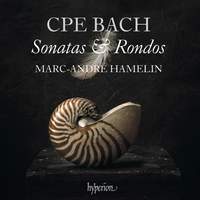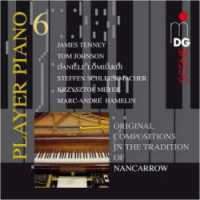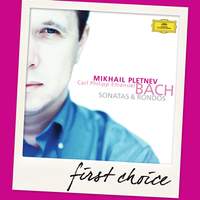Interview,
Marc-André Hamelin on CPE Bach
 Over the course of a very solitary Christmas last year due to COVID-isolation, I could hardly have wished for better musical companions than Marc-André Hamelin and CPE Bach - the Canadian pianist's generous selection of the composer's sonatas and rondos (released earlier this month on Hyperion) brims over with a warmth and humour which considerably enlivened what could have been a rather dispiriting festive season.
Over the course of a very solitary Christmas last year due to COVID-isolation, I could hardly have wished for better musical companions than Marc-André Hamelin and CPE Bach - the Canadian pianist's generous selection of the composer's sonatas and rondos (released earlier this month on Hyperion) brims over with a warmth and humour which considerably enlivened what could have been a rather dispiriting festive season.
After making contact on Twitter (where his posts are invariably as witty and enlightening as his music-making!) over the holidays, Marc and I spoke via video-call about his very first performance of CPE Bach's music at the tender age of nine, how his relationship with the composer deepened in recent years, the kinship which he sees between CPE Bach and Haydn, and why he's uninterested in 'difficulty for its own sake'...
How far back does your relationship with CPE Bach extend, and what was the impetus for this project?
I did this recording out of sheer love for the music - and out of hope that it might incite more pianists to look into it, because it’s a fascinating trove of treasures. To give you an idea of CPE’s output, the Urtext edition of his keyboard works runs to eighteen volumes! There are over 150 sonatas, many of which hadn’t even been published until quite recently.
I actually played CPE Bach before I was even aware of it: my very first appearance in public was in a competition when I was nine, and the first piece in the first group was a little march which the score listed as being by JS Bach, but it was later discovered that it was in fact by CPE! So CPE Bach turned out to be the first composer I ever performed.
I was aware of who he was, of course, from a fairly early age - but other than that little march, the one piece of his that I knew (like almost any pianist) was what we now call the Solfeggietto in C minor (although it’s actually called ‘Solfeggio’, and is identified as such on my recording). In 1999 I wrote a piece specifically for player-piano, based on the C minor Solfeggio: you hear it five times, each time with a voice added, and by the time it ends you have five voices running in sixteenth-notes so it’s pretty overwhelming. It was just meant to be fun, really, and it’s out there somewhere on the MDG label. I do also remember playing a trio in B flat major for harpsichord flute, violin – but that was so long ago that I couldn’t possibly give you a catalogue-number!
The real shock for me came in 2008 or 2009, thanks to my wife Cathy who’s a classical radio host here in Boston. I was sitting at home listening to her broadcast; I remember she played one cut from Mikhail Pletnev’s CPE Bach CD on Deutsche Grammophon, that little sonata in E minor which is also on my recording. It’s very short - only seven or eight minutes - with three movements attacca, and he ends the piece literally in the middle of a phrase: that’s a pretty astonishing thing to do, especially when you remember that this is the 1780s we’re talking about! And that’s just one of the many things that underlines the fact that CPE Bach was really quite avant-garde. Part of it was a reaction against his father’s style, but I think it was always there deep down inside him anyway: even from the very beginning when his writing was a little bit more conservative, there are so many new and original touches.
So that radio programme really planted the seed, but I didn’t really start exploring him until maybe three or four years ago, when the idea of recording these things really took shape. At first it was only supposed to be one CD, but I just couldn’t choose after a while because there was so much wonderful stuff! And this was even before I discovered quite how much came out of his pen…I started by buying every single edition I could find, and then out of the blue I received an email from Paul Corneilson, the managing director of the new Collected Works edition put out by the Packard Humanities Institute; he had evidently gotten wind of the fact that I had a project going, and offered me an 18-volume set of the complete works for keyboard! So the one-CD project naturally expanded to two discs. Incidentally, the entire contents of the edition can be downloaded at CPEBach.org, which is a golden opportunity to get to know the music more easily.
When we spoke to your fellow pianist Víkingur Ólafsson about his recent Mozart and Contemporaries project, he confessed to feeling quite ‘conflicted’ about CPE Bach, reflecting that ‘although I don’t like so much of his music, I do find it immensely interesting’: I assume you’re on quite different pages in that regard?!
Oh, I find his music so touching. The originality is touching, but so is the music itself - there are so many lovely things. One of my favourite encores these days is a piece called La Complaisante, which is a beautiful slow and stately minuet; it’s only a page long and very simple to play, and I think amateur pianists should just flock to it. To me it’s one of the most perfect encores that I could imagine.
Is it fair to say that you’ve always been attracted to music which pushes the boundaries of what was possible on keyboard instruments of the time - and if so, was that part of the appeal of CPE Bach’s music for you?
I have to qualify that, because what I’ve always been attracted to is the orchestral, dense, contrapuntal side of piano writing, and it so happens that pieces that are written in that idiom are often very challenging to bring off. But despite appearances – and I know plenty of people will double-take here! – I’m not interested in difficulty for its own sake. Especially in summer concerts, I’m not up for playing something like the Alkan solo piano concerto and ending up in a puddle on the floor! I’ve done all that, and I actually don’t play that particular work any more. Music is music, and the fact that CPE doesn’t really present any pianistic difficulties is completely unimportant to me: the music is so rich, vibrant and exciting that that side of things doesn’t even enter into my mind.
It’s certainly a change of pace from the Liszt/Thalberg album you released in 2020…!
My thanks for your appreciation of that one at Presto! I’d toyed with the idea of issuing an all-Thalberg disc, looking at the opera fantasies, but the trouble was that I couldn’t find anything else of his that really convinced me beyond those two paraphrases that ended up on the album; however, there was also some Liszt that I really wanted to get off my chest on CD, so that’s why I decided to combine both. I didn’t actally intend the reference towards the famous ‘duel’ that they did, otherwise I would have really researched that and presented what I thought they’d played on that particular day. That element was entirely secondary; I just wanted to play some of my favourites, and present what I thought was really representative of both composers.
You play a modern Steinway on the recording: did you take any of this music onto the instruments of CPE Bach’s time during your explorations?
No, I’ve never really tried to replicate any sound from the past - first of all because the modern piano and its temperament is what I grew up with, so the tuning would be sort of foreign to my ear. But I think it’s a testament to the force and the strength of CPE Bach’s music that it can withstand being performed on anything, really. I know what a clavichord sounds like, and what the possibilities are: I have a favourite video of Friedrich Gulda playing one of his own pieces, For Rico, which he wrote for his son. He plays an amplified clavichord, and it’s so unlike the image that you usually get from people who play the repertoire of that period in which it existed: it shows all of the potential within the instrument and it’s just fantastic, but personally I prefer to concentrate on developing my own set of expressive possibilities within the modern piano. I asked the wonderful harpsichordist Mahan Esfahani to write the notes for my recording, because I knew he would produce something ideal: I know Mahan personally and he’s a totally fascinating musician and person, so that was a no-brainer!
Did you find it useful to consult CPE Bach’s great treatise on ‘The True Art of Playing Keyboard Instruments’ when you were preparing for the recording?
In a certain sense, yes – I’m not sure that it really helped me for the repertoire, but it’s fascinating to see his trains of thought. I haven’t actually read the entire thing, but it’s something that I would certainly recommend to anyone interested in piano music: Beethoven placed such stock in it, as did many other of the greatest composers and musicians of that period (and indeed subsequently). Haydn acknowledged CPE’s influence, and one can definitely see common points there: the angularity, sometimes the total surprises, the quirky little things that seem to lurk at every corner. It’s always a joy to compare them.
Without wishing to tempt you into too many spoilers, could you pick out one or two ‘surprises’ as a taster?!
There’s a little Rondo in C minor which ends right in the middle of a phrase, like that E minor sonata I mentioned earlier. The question is how you treat that as an interpreter, because it’s written without a ritardando or anything like that: I’ve heard people slow down into it, but I elected to leave the stopping of the music completely unexpected, because it’s so refreshing to me to see a composer thinking aloud and going ‘OK, I’ve said enough now!’.
Which works from the album have featured (or will feature) in your live recital-programmes?
I’ve played the second Württemberg Sonata in A flat major on occasion, and I’m touring with the E minor suite (which is sometimes called a sonata) this season. This was something that I really wanted to do, because these are pieces that are particularly wonderful: one so often hears JS Bach’s French Suites, English Suites and Partitas, and this E minor suite is wholly on a level with all of those. There’s absolutely no reason that it should be neglected.
Is there anything you can share with us about your recording plans?
I’m eventually going to record another CD of my piano music because I do have enough to fill a disc, and I recently finished writing a piano quintet that I’m hoping to record. I’ve also been touring with the Hammerklavier this season and hope to do that on CD too at some point, but I’m going to wait a while because that piece is something that you just don’t rush!
Marc-André Hamelin (piano)
Available Formats: 2 CDs, MP3, FLAC, Hi-Res FLAC
Player Piano Volume 6: Original compositions in the tradition of Nancarrow
including Hamelin's Solfeggietto a cinque for player piano (after CPE Bach)
Bösendorfer-Ampico Player Piano
Available Format: CD
Mikhail Pletnev (piano)
Available Formats: MP3, FLAC





